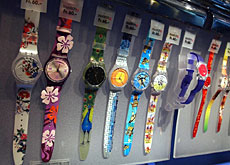The Swatch celebrates its 20th birthday

The Swatch Group is celebrating the 20th anniversary of the Swatch, whose staggering success did much to rescue the Swiss watch industry in the 1980s.
The fashion timepiece rapidly became a competitor to cheap quartz watches produced in the Far East, which had threatened to put Swiss watchmakers out of business.
The Swatch was launched in Zurich on March 1, 1983, with 12 models priced at between SFr39 and SFr50. It became an instant hit in Switzerland.
Some months later, the Swatch Group launched a high-profile advertising campaign for its timepiece in the United States, which sent global sales rocketing.
Some 3.5 million Swatches had been sold by the end of 1984.
“There was this brilliant idea to sell the Swatch as a fashion accessory and to make sure it was always up to date with the latest trends,” Harald Zahnd, a luxury goods analyst at Credit Suisse, told swissinfo.
The Swatch was up-dated every six months with the launch of 30 new models.
The lightweight, plastic watch was produced cheaply and easily using an integrated production technique that reduced the number of parts from 100 to 51.
“The Swatch had a huge impact on the global watch industry,” Andrea Maputo, head of marketing for Swatch, told swissinfo.
“And the concept of having a Swiss-made luxury product that’s affordable is still very relevant today – especially in the current economic climate.”
Crisis years
The success of the Swatch watch did much to rescue the Swiss watch industry from a crisis brought about by fierce competition from Japanese quartz watches.
The crisis came to a head in the early 1980s, when Switzerland’s two largest watchmakers, ASUAG and SSIH, were facing liquidation.
Foreign competitors were eyeing their prestigious brand such as Omega, Longines and Tissot, and the two firms needed to come up with a strategy to save the industry in Switzerland.
“There was heavy competition from Japan and the problem was the Swiss didn’t know how to market their timepieces, only how to make them, and this was very important,” Zahnd explains.
Timely rescue
Nicolas Hayek, at that time CEO of Hayek Engineering, received an assignment to develop a strategy for the future of both companies.
In 1983, he recommended several measures, notably the merger of ASUAG and SSIH into SMH, and the launch of a low-cost, high-tech watch – the Swatch.
Its design was taken from existing ASUAG prototypes for fully integrated watches, which had been developed since 1978.
The Swatch was then given a vibrant range of colours… and a touch of marketing genius.
“Hayek showed the Swiss how to market their watches and that was one of his main contributions to the industry,” Zahnd says.
“It’s success helped [SMH] reduce its debts and evolve other brands such as Longines and Omega.”
Legacy
The popularity of the Swatch continued to grow and by 1989, with Hayek as CEO, the SMH Group was the world’s largest watchmaking company.
But while the Swatch brand has remained solid, Zahnd says the trend has now moved away from low-cost timepieces.
“The Swatch watch will go on for a long time, and its very important for the Swatch Group brand name, but the problem is that its profit margin is very low,” says Zahnd.
“That’s why in the 1990s, Swiss watchmakers shifted their focus to luxury watches where the margin is higher.”
This move to high-end timepieces has come under fire from Hayek, who recently stepped down as CEO of the Swatch Group. He warned in January that the Swiss watch industry was badly in need of a shake-up.
“[In the past few years] companies have been running after money, money, money,” Hayek told swissinfo. “[There’s] no innovation and no new development.
“[The industry needs to reform] otherwise it will suffer exactly the same problems it had before and it will go down.”
Zahnd agrees that the industry needs to change. “Swiss watch manufacturers should revamp the image of all their watches, not just the luxury brands.”
No celebrations
For its part, the Swatch Group is not planning to celebrate the birthday of its winning timepiece.
“It’s a nice birthday but it’s not so significant – some of our brands are over 150 years old,” says Maputo.
“And 20 years represents the age of maturity, whereas the Swatch is always going to be the rebel, the young kid of the Swatch Group family.”
swissinfo, Vanessa Mock
The Swatch was launched on March 1, 1983, and one million were sold within 12 months.
To date, 300 million Swatches have been sold, with 2,500 models launched on 80 markets.
The Swatch was developed from existing models of fully integrated timepieces that halved the number of parts and were cheap to produce.

In compliance with the JTI standards
More: SWI swissinfo.ch certified by the Journalism Trust Initiative










You can find an overview of ongoing debates with our journalists here . Please join us!
If you want to start a conversation about a topic raised in this article or want to report factual errors, email us at english@swissinfo.ch.